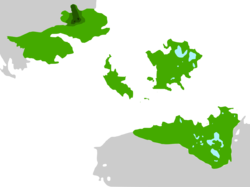Helsonian Union
| Great Union of Helsonian Communist Republics (UHCR) Folś Heelsec Qomyći Ozysƿoqi-Resfoƿeece (HQOR) |
||||||
|---|---|---|---|---|---|---|
|
||||||
| Motto: "Naitidana arida" Unnoficial; "Okonaran yu midod drav or" |
||||||
| Anthem: Great Anthem of the Union of the Helsonian Communist Republics | ||||||
Map of the UHCR
|
||||||
| Capital | Kóri | |||||
| Largest city | Gjeerny | |||||
| Official languages | Terminian/Cermani | |||||
| Ethnic groups (2009) | 86.6% Terme (including Amec) 7% Xynder 5% Nithalosian 1.4% other | |||||
| Demonym | Helsonian | |||||
| Government | Kuulist Single-party state | |||||
| - | Secretary-General | Hari Ćer | ||||
| - | Premier | Joś Muur | ||||
| Legislature | Great Helsonia | |||||
| - | Upper house | Helsonians of the Union | ||||
| - | Lower house | Helsonians of the Republics | ||||
| Establishment | ||||||
| - | Establishment of the Terminian Empire | 400 CE | ||||
| - | Fall of the Terminian Empire | 1594 | ||||
| - | The Civil War of Unity between the Unitists and the Seperatists | December 1745 | ||||
| - | Union of the Three Kingdoms | 23rd February 1790 | ||||
| - | Establishment of the Kuulist idea in Terminian | 9th June 1895 | ||||
| - | Terminian Revolution | 10th October 1925 | ||||
| - | Fall of the Union | September 2015 | ||||
| Area | ||||||
| - | 1,195,267.945 km2 (?) 461,495.55 sq mi |
|||||
| - | Water (%) | Unknown | ||||
| Population | ||||||
| - | 2009 census | 47,309,974 | ||||
| - | Density | 39.58/km2 (Unknown) 102.5/sq mi |
||||
| GDP (nominal) | 2001 estimate | |||||
| - | Total | US$269,666,851,800 (Unkown) | ||||
| - | Per capita | 5700 | ||||
| Gini (2001) | 32 medium · Unknown |
|||||
| HDI (2001) | 0.6 medium · Unknown |
|||||
| Currency | Helsonian Jikve (I) (HLJ) | |||||
| Time zone | Köre Time (Eastern Sarkunen Time) (SCT+1) | |||||
| - | Summer (DST) | +1 (SCT+2) | ||||
| Date format | yyyy/m/dd | |||||
| Drives on the | left | |||||
| Calling code | +24 | |||||
| Patron saint | Pašaist Saint Emperor Séér | |||||
| Internet TLD | .hu | |||||
The Helsonian Union (IPA: /hɛˈlsoʊniən ˈjuːnjən/, Helsen: Heelsyi, IPA: /hɛ:lsʲã/), officially the Great Union of the Helsonian Communist Republics (sometimes abbreviated "OHKR" after the Old Terminian for the full name), was a Kuulist state, straddling Šarkunen and Baredina with three autonomous "Communist Republics": Great Terminia, Utol and Amerhan. It was governed as a single-party state by the Communist Party with Kóri as its capital. Covering approximately 1.2 million square kilometers, the UHCR was the world's (number)th largest country by land area. The UHCR's climate was hot, owing to its proximity to the equator and the Tropic of Cancer, and had a landscape ranging from rainforests in the tropical south to bushland in the arid north. The Nepish mountain ranges in the north ran along the Nithalosian and Lesidean border, and the Hälentö lakes lay at the south of Utol. The Helsonian Union had its roots in the Terminian Revolution of 1925, which overthrew the Three Kingdoms. Led by Hari Tjelo, the revolution established the Terminian Communist Helsonian Republic, beginning a civil war between pro-communist Ambers and counter-revolution Lilacs. The Amber Army entered the previous regions of the Three Kingdoms, now in turmoil, and helped local Communists take power through helsonias that nominally acted on behalf of workers and peasants. In 1935, the Communists were victorious, forming the Helsonian Union with the unification of the Great Terminian, Utollic and Amerhani republics. Tjelo suppressed political opposition to him, committed the state ideology to Radical Communism and initiated a centrally planned economy. As a result, the country underwent a period of rapid industrialisation and urbanisation. However, Kale established political paranoia, and introduced arbitrary arrests on a massive scale after which the authorities transferred many people (military leaders, Communist Party members, ordinary citizens alike) to correctional labour camps or sentenced them to execution. After Tjelo's death in 1951, his son, Kale Tjelo, came to power. Following Kale Tjelo's end of term as the first Secretary-General in 1967, a period of moderate social and economic liberalisation occurred under and after the administration of Viktor Tjendasen. The UHCR went on to initiate significant technological developments of the 20th century, including the development of the first word processor in 1968. The election of Tomas Jetlov as Secretary-General led to tension between the UHCR and it's northerly neighbours in Šarkunen, and, after several violations of international law, the Šarkunen Economic Union partially embargoed the nation. In the 1970s, a relaxation of relations followed, but tensions resumed when the Helsonian Union began providing military assistance in (somewhere in Baredina) at the request of its new Extreme Kajlist government in 1979. The UHCR was a relative latecomer to extreme industrialisation compared to its Sarkunen neighbours and, during the course of the 20th century, remained largely agrarian until the early 1940s. The Helsonian Union was a top performer in numerous metrics of national performance, including unemployment, economic competitiveness and human development. However, it had long come under fire for its anti-nonhuman and anti-transsexual views. About 36.6% of citizens polled in the UHCR in 2014 expressed far-right opinions on issues such as race, species and gender. Notably, Helsonia did not hold views against homosexuality, due to the historical Pashaist practice of Fáár, religious homosexuality.
Etymology
The term "Helsonia" comes from the Old Terminian word "Hjelsen", roughly translated as council.


